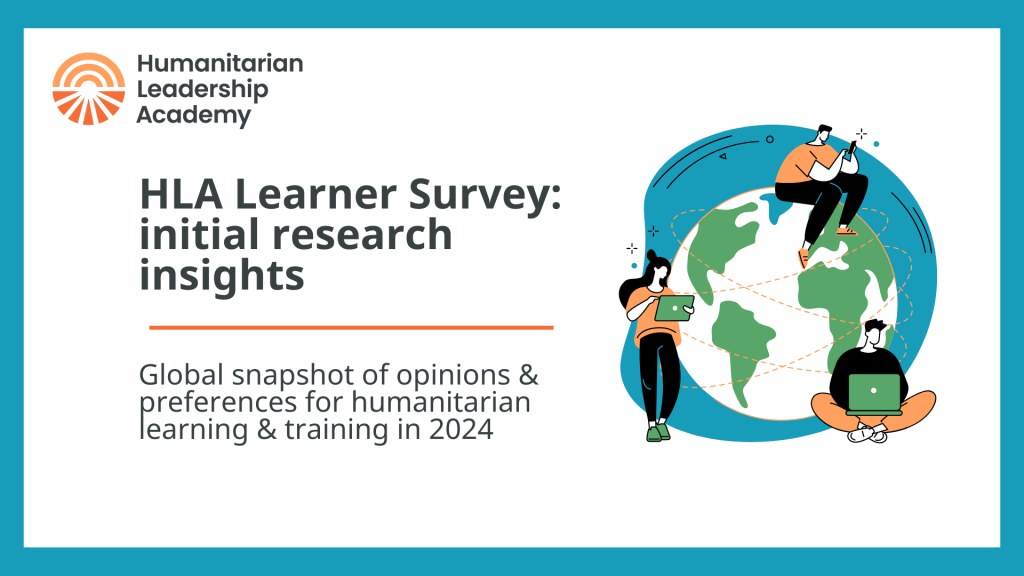
In April, we launched the HLA Learner Survey to ask the global humanitarian community their opinions and preferences for humanitarian learning and training. We’re excited to now share initial research insights with the sector.
We invited our 700,000-strong global learning community and wider humanitarian network to take part in the survey, with the option to participate in English, Arabic, French or Spanish.
There was a truly global response, with 4,758 humanitarians from more than 200 countries completing the survey over one month.
There were high levels of interest and willingness to participate in this research and to share opinions and views with us, reflecting the community’s dedication to enhancing humanitarian learning. We extend thanks and appreciation to everyone who engaged in this research.
Together these insights build a rich picture of the humanitarian learner community’s current needs and preferences. The findings will help us to ensure our learning products and services continue to meet sector needs, as well as support our partner organisations through insights relevant to their work and mission.
Key takeaways
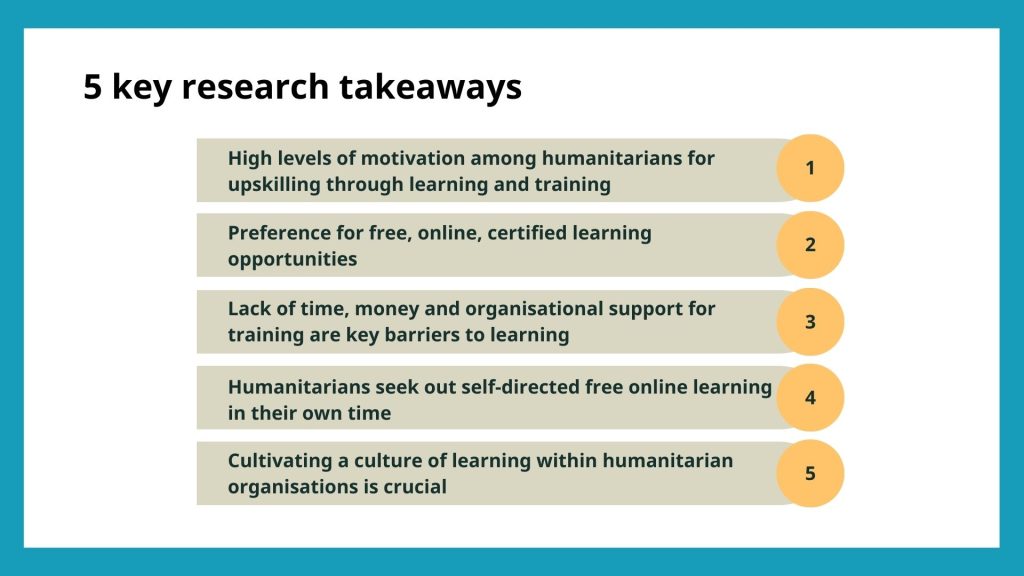
- High motivation for upskilling: Humanitarians are driven to continuously enhance their skills to improve their effectiveness in current and future roles, with a focus on both technical and project management skills.
- Preference for online learning: Affordable, accessible, and certified online learning is the favoured format among those surveyed for training and skills development.
- Challenges to learning: Time constraints, high costs, and insufficient organisational support are significant barriers that hinder humanitarians’ ability to pursue training and learning opportunities.
- Self-directed learning solutions: Despite these challenges, humanitarians overcome barriers through self-directed free online learning, actively seeking out relevant opportunities through newsletters, online searches, and social media.
- Importance of organisational support: Cultivating a culture of learning within humanitarian organisations is crucial. This includes encouraging diverse training formats, allocating time for learning, and providing broader training opportunities in collaboration with humanitarian training providers to create contextually-relevant learning and training.
In a series of graphics and brief commentary, we take a closer look at the responses and present a global snapshot of the findings.
1. Respondent profile
Humanitarians from across Africa had the highest levels of engagement with this global survey, with eight of the top ten country responses received from the continent: 1. Nigeria (367), 2. Democratic Republic of Congo (278), 3. Ethiopia (256), 4. Kenya (250), 5. Burkina Faso (230), 6. Cameroon (181), 9. Uganda (160), and 10. Niger (145).
In Asia, 171 individuals from Afghanistan participated in the survey, making it the country with the seventh-highest number of survey respondents.
Meanwhile, in the Middle East and North Africa region, 161 people in Syria took part in the survey – the eighth-highest number of responses.
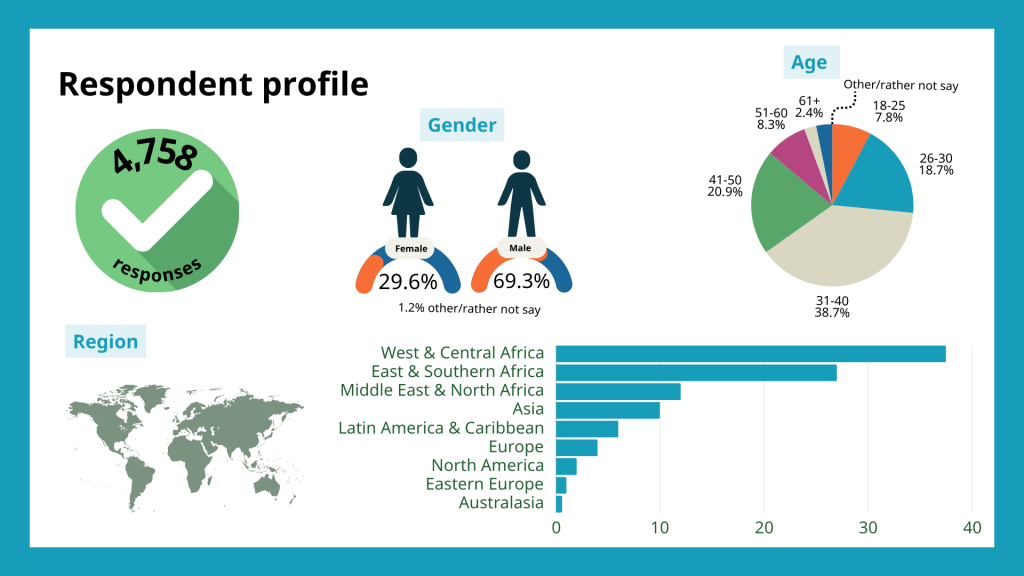
The majority of respondents are working in the humanitarian sector as employees (51.7%) or as volunteers (20.4%), holding positions at entry level (30.3%) and manager level (27%) within NGOs/non-profits (74.6%).
Almost one-fifth of respondents are not currently involved in the humanitarian sector but would like to be in the future (19.1%), while a further 6.2% are currently students.
Collectively, more than half of respondents belong to local (11.9%), national (24.7%) or regional organisations (17.1%); while respondents from international organisations made up 46.3% of responses.
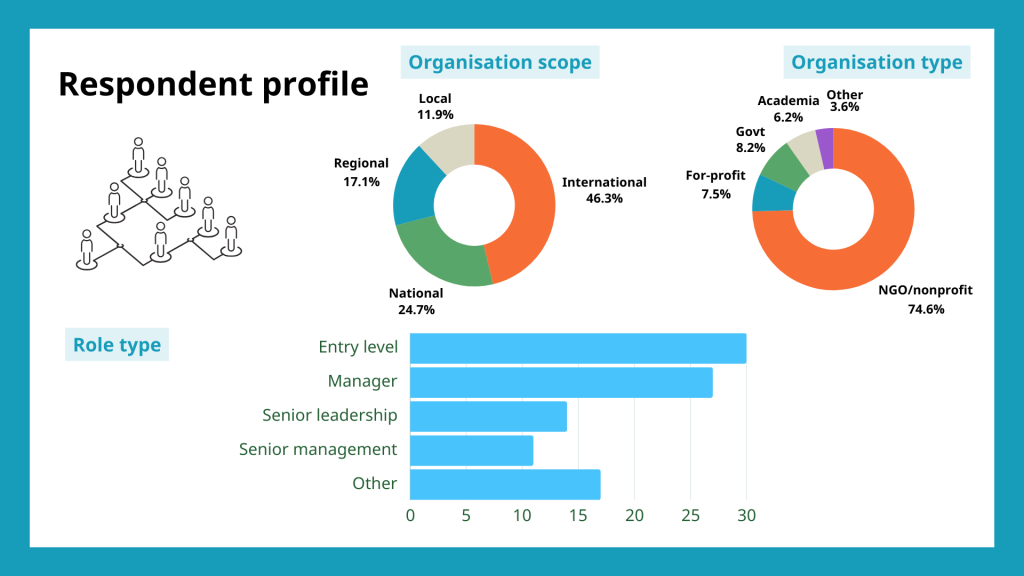
The top five work areas respondents are currently involved in are: 1. education (8.6%); 2. health (7.9%); 3. project management (7.7%); 4. protection, diversity and inclusion (7.5%); and 5. food security and livelihoods (6.9%).
2. Main reasons for accessing learning and training: upskilling and career advancement
A theme emerging in this area is that respondents are motivated to learn to boost their knowledge for their current role and to enhance their career prospects.
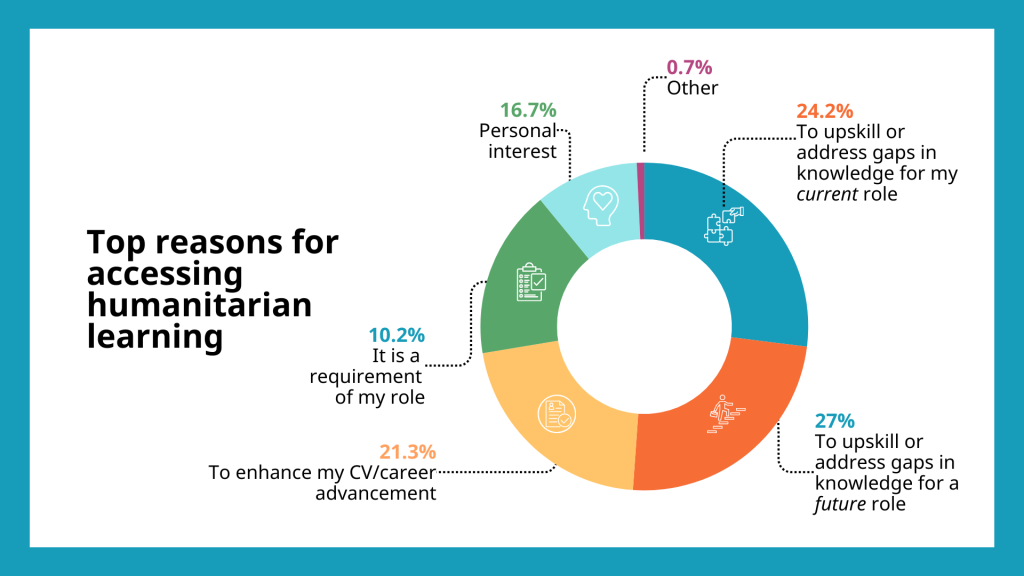
More than half of respondents are undertaking humanitarian training and learning to upskill for future roles (27%) as well as address gaps in their current roles (24.1%).
More than a fifth of respondents (21.3%) are motivated to learn for the boost to their professional credentials and career advancement.
3. Main areas of interest: thematic professions
The top five areas of interest for humanitarian learning align with respondents’ current areas of work (as highlighted in section 1) – but in a different order of priority: 1. food security and livelihoods (9.5%); 2. health (8.5%); 3. protection, diversity and inclusion (8.4%); 4. project management (8.3%); and 5. education (7.8%).
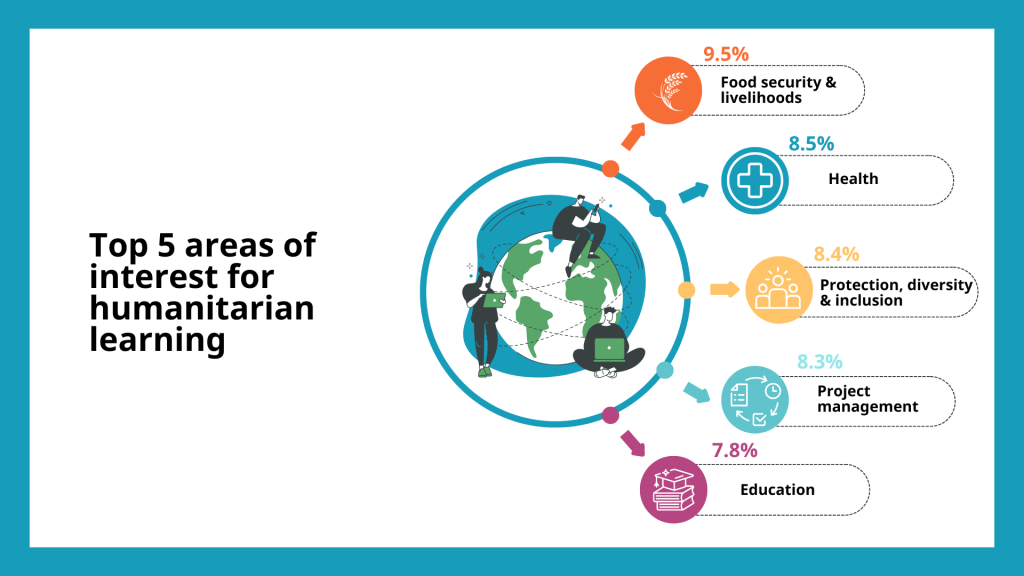
It is interesting to observe the high proportion of respondents already engaged in as well as developing in roles which can be categorised as thematic professions, engaged in services related to a specific theme or type of intervention.
Complementing this is the current involvement and interest in project management – a function/job role supporting humanitarian interventions to be delivered effectively.
4. Top reasons driving learning and training choices: certification, affordability, relevance
Respondents are strongly motivated to undertake training which offers a certificate (22%) and is affordable or free to access (20.8%).
Relevance of learning content was also a key consideration, with respondents stating that this was important for their future career plans (14.7%) and current role (12.4%). It is interesting to see this slight emphasis placed on the importance of training relevance to future career plans over existing roles.
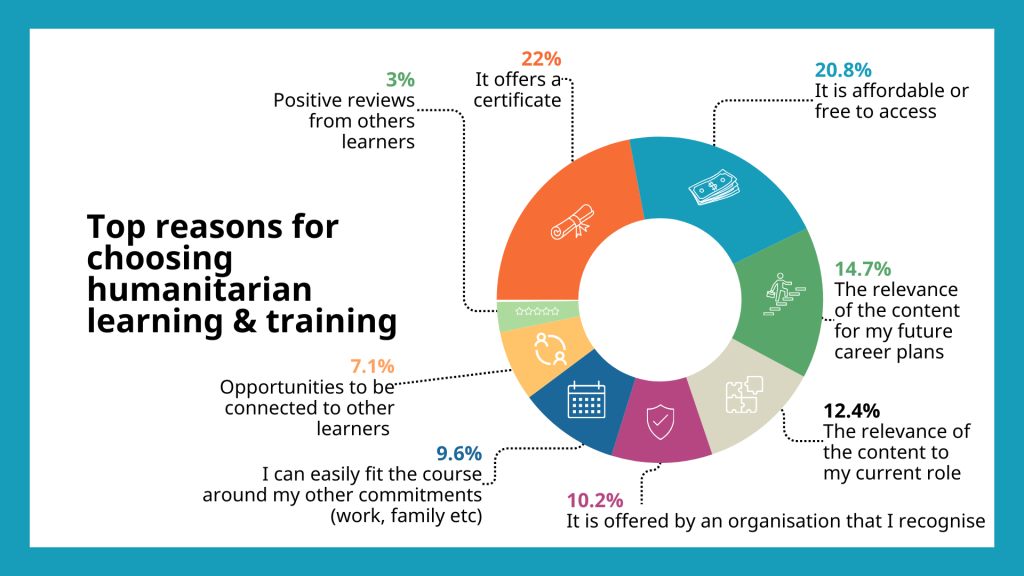
5. Preferred learning formats: e-learning comes out top overall – Arabic-speaking respondents favour face-to-face training
Overall, respondents expressed a preference for e-learning for humanitarian learning and training (23.2%). Face-to-face training in a group was ranked second, with 19.6% of respondents stating a preference for this format. There is also significant interest in one-to-one coaching or mentoring (15.4%).
While this is the finding at the global level, it is important and interesting to note that respondents to the survey in Arabic expressed a preference for face-to-face learning over e-learning.
[More on this to follow in future instalments of these research findings where we’ll dig deeper into these variations by region, survey language response etc].
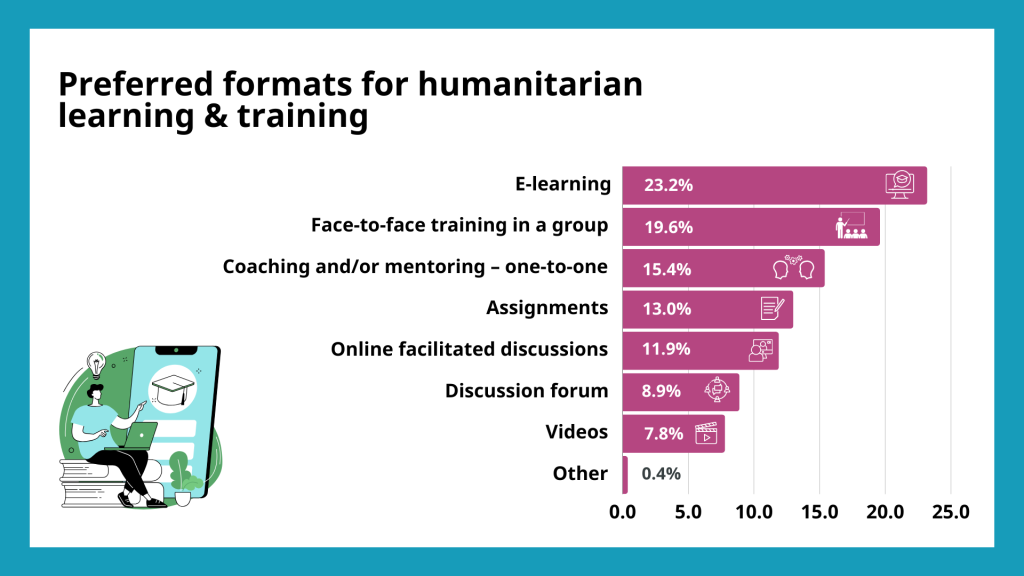
At the global level, this overall preference for e-learning may be linked to the importance of affordability, as highlighted in section 5. It is noted that this weighting may also be due to the majority of survey respondents being existing members of our online learning community on Kaya.
6. Top forms of learning undertaken over the past six months: free online learning coupled with workplace learning
Survey respondents have engaged in a broad range of humanitarian learning and training over the past six months, the top three formats being self-directed online learning (16.5%) together with on-the-job learning (11.0%) and in-person workplace training (10.3%).
The popularity and prevalence of self-directed free online training indicate that survey respondents are highly motivated and committed to self-development to complement organisational learning.
Linked to the importance of affordability of training, it is noteworthy that a relatively low proportion of respondents have stated that they have undertaken self-funded face-to-face training in the past six months (4.5%).
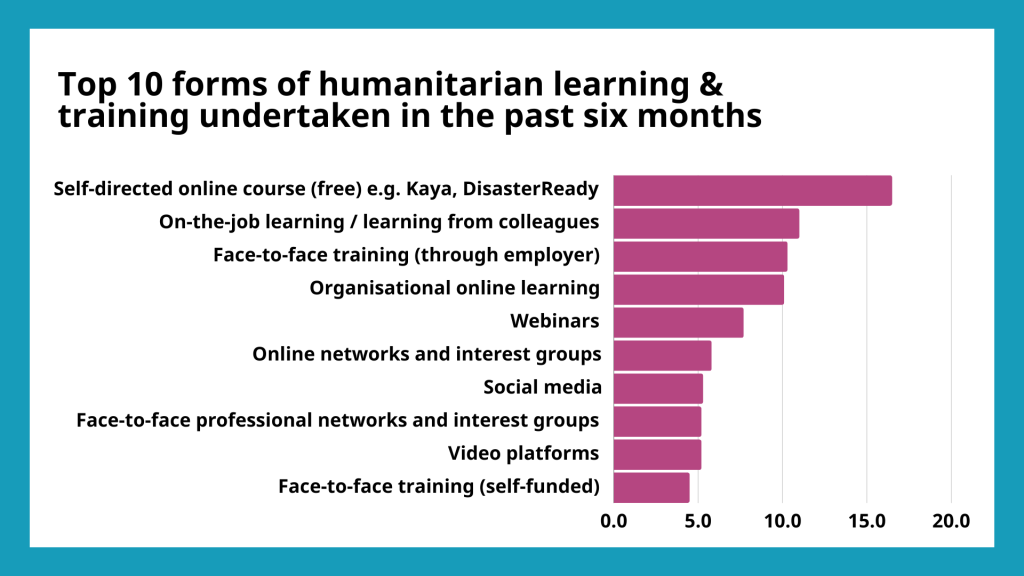
7. Main channels for finding out about learning opportunities: newsletters and online searches
Online communication is the main way respondents find out about humanitarian learning opportunities, with the top five ways stated being online channels.
Email newsletters are the main way respondents stay informed (28.3%), followed by online searches (17.5%), messaging platforms such as WhatsApp (15.9%), and social media platforms LinkedIn (14.2%), and Facebook (8.9%).
This highlights the importance of humanitarian training providers to disseminate opportunities in a timely and accessible manner across relevant platforms.
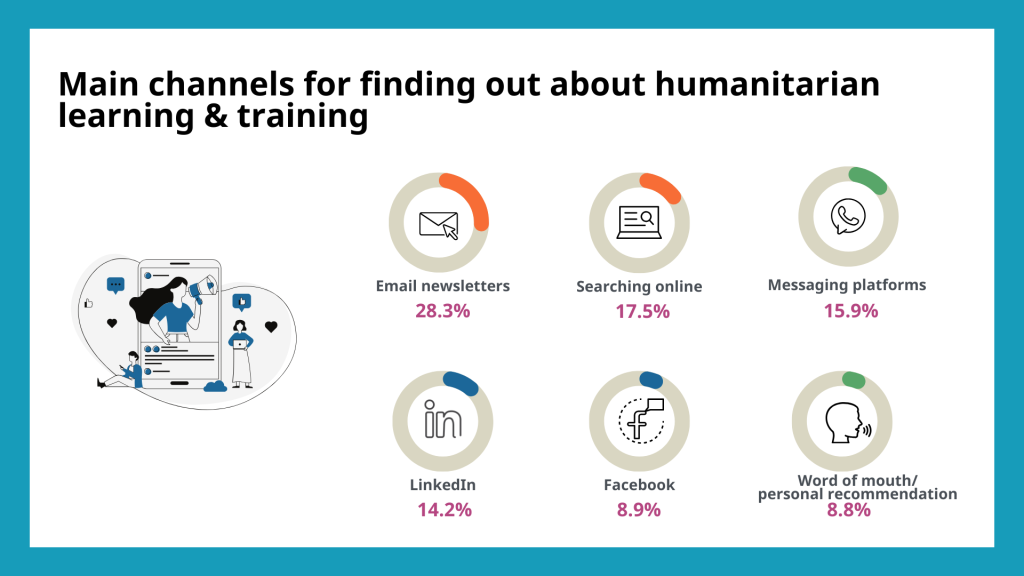
8. Main barriers: lack of affordable opportunities and time
A finding that can be drawn from the survey responses is the importance of affordability of learning and training opportunities.
Around one-quarter of respondents said that the main barrier to undertaking learning and training is a lack of affordable training opportunities (24.7%). Busy schedules were also cited as a barrier (16.8%), as well as a lack of support from their organisation (12.8%).
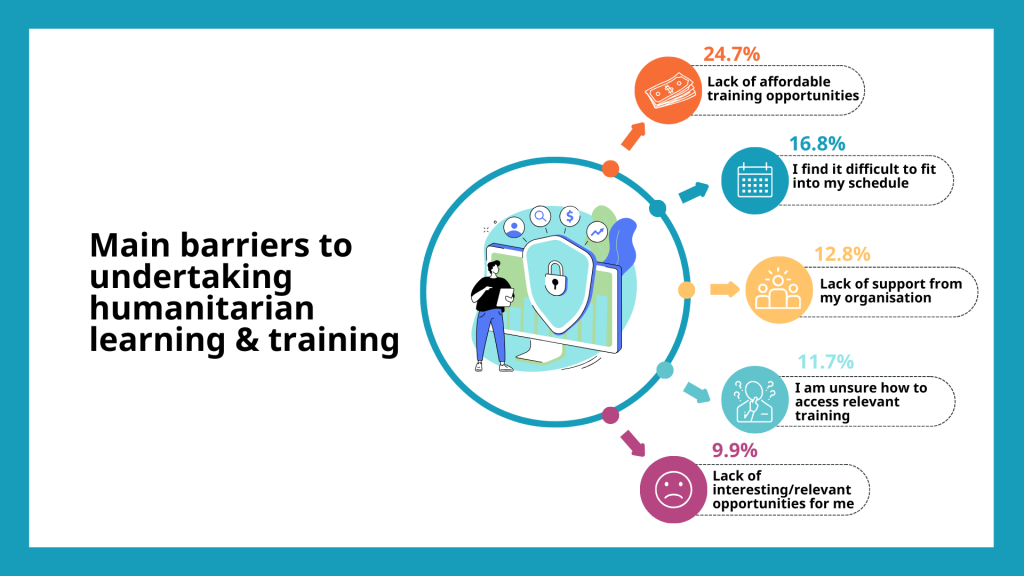
It’s also notable that while there is interest in training and learning opportunities in general, respondents report struggles seeking out relevant opportunities (11.7%) that are of personal interest (9.9%).
Next steps
From these insights, a picture emerges of current and aspiring humanitarians who are motivated to learn, upskill and progress – but face barriers to accessing affordable, relevant and interesting opportunities that can fit into busy schedules.
We encourage humanitarian organisations to use these insights to start conversations around training and learning within their teams. What do you think can be done to help reduce or overcome these barriers within your organisation?
We encourage leaders to consider and explore ways to cultivate a culture of learning, enabling humanitarians to feel better supported in their own learning journeys. What actions can you take?
We are committed to using this feedback to refine and enhance our own learning products and services as well as sharing relevant insights with partners. Stay tuned for further research insights!
Learning resources
Explore a range of free, open-access resources for humanitarians in a range of languages through our channels:
Access online learning
- Kaya offers free, accessible, high quality and contextually relevant learning opportunities for the humanitarian sector.
- The Response Learning Hub provides up-to-date and relevant learning resources to support our global humanitarian responses.
- On our Resources Hub you can access our events, articles, podcasts, reports, infographics, microlearning guides, and case studies.
- The HLA’s YouTube channel is regularly updated with humanitarian learning video content including microlearning animations and webinar recordings.
Stay up-to-date and informed
- Learn about our latest work including training and events around the world via our news page.
- Sign up for our newsletter
- Follow us on LinkedIn, Facebook, Instagram and X (Twitter)
Kaya for organisations
If you are from an organisation interested in using Kaya to design and manage your own training content, visit our Kaya for Organisations page. You can also email our Sales team at partnerships@humanitarian.academy for more information.
HPass
If you are an individual or organisation interested in learning more about HPass digital badges that showcase humanitarians’ learning achievements and provide global recognition with verified credentials, visit our HPass website.
About the authors
Esther Grieder is the Global Partnerships and Communities Lead at the HLA. She has 20 years of experience in the international development and humanitarian sectors, working primarily on education, youth, health and humanitarian issues. Esther holds a BA and MA in History. Esther led the data analysis stage of this project. After eight years at the HLA, in July 2024 Esther will take up a new role as Director of Membership Engagement at NetHope.
Ka Man Parkinson is the HLA’s Communications and Marketing Advisor. She has extensive professional experience within the international education and non-profit sectors gained in roles at three UK universities and at the British Council. She holds a BSc in Management and IT, an MA in Business and Chinese, and a CIM Professional Diploma in Marketing. On this project, Ka Man co-designed the survey with Esther and produced this commentary and supporting graphics.
Note
This research was conducted in April – May 2024. This overview presents the aggregated responses from the four surveys in English, Arabic, French and Spanish. The findings in this article are for information purposes only.
The authors would like to thank colleagues who lent their support to this project including Salma Babban, Anne Garçon and Ana Lucia Villagran for reviewing survey translations, and Lucy Hall for providing a sounding board for data approaches.
Contact
We aim for these research findings to spark a wider conversation on humanitarian training and learning. We invite any comments, queries or feedback:
HLA Communications and Marketing team
info@humanitarian.academy

